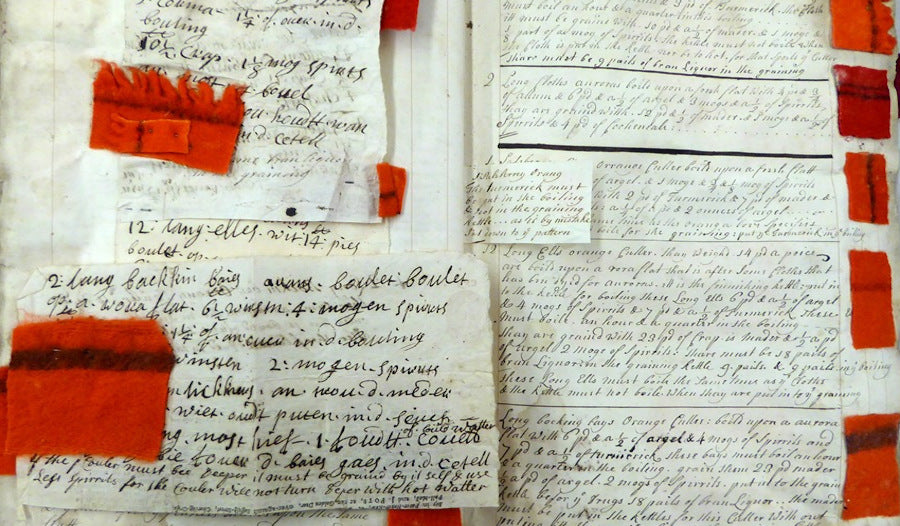
BEREA ANTAKI Little Book of Swatches
Image courtesy of Southwark Heritage Blog
A collection of great importance to historians of textile production in England has made its way to archival safety. The Crutchley family were dyers in the 18th century with dye-works in Southwark, located near the south bank of the Thames between Clink Street and Deadman’s Place. Fourteen of the Crutchley’s dyeing and business account books dating from around 1716-1744 were retained by the family. In 2011, the descendants donated this collection to the Southwark Local History Library and Archive after some of the books became water-damaged in storage.
Image © The National Manuscripts Conservation Trust
The three books selected as conservation priorities are the earliest in the collection. They include a recipe book with instructions for dyeing broadcloth, a pattern book and an ingredient book, all with dyed swatches. It is rare that physical objects relating to dyed textile production of this type and period survive, more so as a provenanced collection in such good condition and extent.
The Crutchley archive presents a rich study resource for historians of textile production and manufacturing. This historical significance was recognized by the University of Glascow’s Centre for Textile Conservation in 2014, when a collaboration was formed with the Southwark Local History Library and Archive to understand and interpret the collection’s contents while preserving the delicate dye samples for future use. A multi-partner interdisciplinary project is underway and headed by Dr Anita Quye, who with the help of University researchers from Glascow, Exeter and the French Centre for National Scientific Research, is working to contextualise this collection in the broader history of European textile production.
Image © The National Manuscripts Conservation Trust
The three books will be treated for mould and water damage. The pages will be cleaned and resized and loose dye samples will be fixed. Once the books are in a more stable condition and fit for handling, they will be digitised. After conservation, the historical research will expand considerably and collaborations will take place between the Southwark Local History Library and Archive and local residents and charities to reproduce the dye samples using the recipes. Further developments will also enable researchers to illuminate the geographical reach of the Crutchley business and examine how far it extended into the Continent.
The significance of this collection was further recognised in 2019, when the collection was inscribed in the UNESCO Memory of the World Register. To learn more about Crutchley archive, visit the Southwark Local History Library and Archive.
Subscribe to Selvedge and explore our most recent issue 98 Together.



